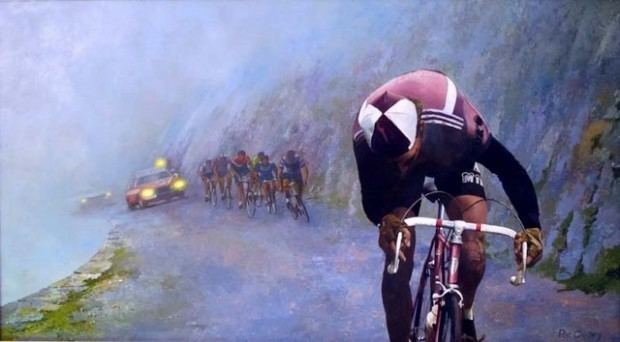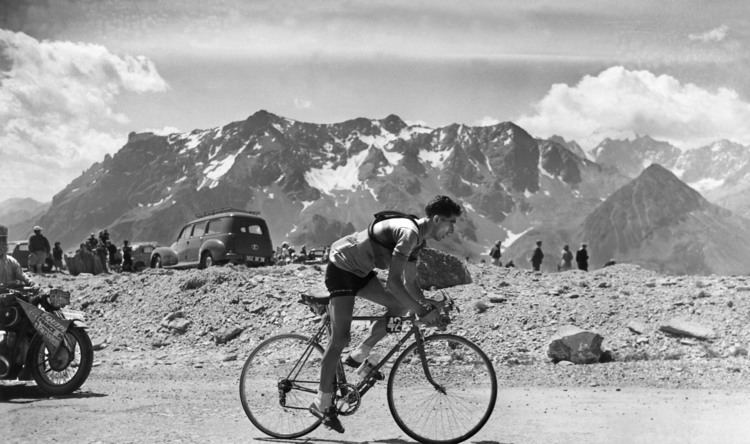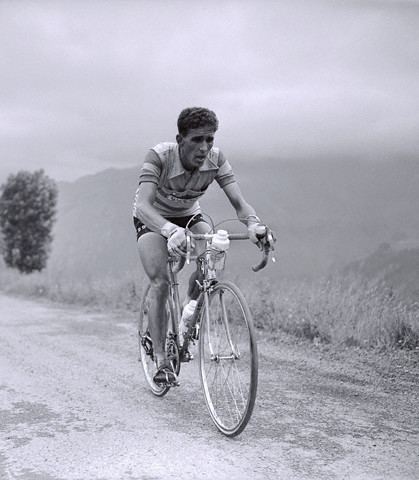1955 Terrot-Hutchinson Discipline Road Name Federico Bahamontes | Rider type Climber 1953–1954 Splendid | |
 | ||
Full name Alejandro Martin Bahamontes Role Professional Road Racing Cyclist Similar People Jacques Anquetil, Luis Ocana, Raymond Poulidor, Lucien Van Impe, Louison Bobet | ||
inCycle Riders: Federico Bahamontes
Federico Martín Bahamontes ([feðeˈɾiko marˈtin βa.a.ˈmon.tes]; born 9 July 1928) is a Spanish former professional road racing cyclist. Born as Alejandro Martín Bahamontes. He is the first cyclist to complete a "career triple" in winning the "King of the Mountains" classification in all three Grand Tours.
Contents

Early life

Bahamontes was born in Santo Domingo-Caudilla (Toledo). His family was devastated during the Spanish civil war and Bahamontes' father, Julián, took the family to Madrid as refugees. There Julian Martín lived by breaking rocks before opening a fruit and vegetable stall: "My father was neither a red nor a fascist - he simply didn't like the idea of people coming along and demanding he give away olives, butter and chickens into which he had put too much work, so we left Toledo," Bahamontes said.

Bahamontes worked as a delivery boy. His hero and eventually his friend was Julián Berrendero, winner of the Vuelta a España in 1941 and 1942 and later selector of national teams.
Career

He began racing in the late 1940s, winning his first race, wearing a baseball shirt on 18 July 1947. It was 12 years to the day before his first Tour de France triumph.
He took the mountains jersey and won the first stage of the 1953 Tour of Asturias at 23, while still not a full professional. The Spanish cycling federation picked him for the 1954 Tour de France the following year and his instructions from the national coach was "Try to win it." He didn't win but he did win the mountains competition and finish 25th.
Bahamontes was a climbing specialist to whom reporters gave the nickname the 'Eagle of Toledo. He rode in a distinctive upright style, staring ahead, his shorts pulled high on his thighs, his hands repeatedly changing position on the handlebars. He won the Tour de France in 1959, and won the Tour's "King of the Mountains" classification six times (1954, 1958, 1959, 1962, 1963, 1964). He also took second and third places overall in 1963 and 1964 respectively. In total, he won seven Tour stages.
He was also second in the 1957 Vuelta a España, and won the mountains competition then and the following year, 1958, when he finished 6th. He also won the mountains competition in the Giro d'Italia in 1956.
Bahamontes was not initially considered a contender for in the 1959 Tour de France, but he benefited from an early escape on a stage in the Pyrenees, and then won a mountain time trial to the Puy-de-Dôme. Into the Alps, he combined with fellow climber Charly Gaul to extend the lead into Grenoble, and although French riders Henry Anglade and Jacques Anquetil cut their deficits, neither made up enough time to threaten Bahamontes' overall lead. He won by just over four minutes from Anglade, and became King of the Mountains too.
Anquetil was whistled as he finished the Tour on the Parc des Princes because spectators had worked out that he and others had contrived to let Bahamontes rather than the Frenchman Anglade win. The French team was unbalanced by internal rivalries. Anglade was unusual in that he was represented by the agent Roger Piel while the others had Daniel Dousset. The two men controlled all French racing. Dousset worked out that his riders had to beat Bahamontes or make sure that Anglade didn't win. Since they couldn't beat Anglade, they contrived to let Bahamontes win because Bahamontes, a poor rider on the flat and on small circuits, would be no threat to the post-Tour criterium fees that made up the bulk of riders' - and agents' - earnings.
In 1960 Bahamontes got no further than the first few days of the Tour. The writer Roger St Pierre said: "One of the most poignant photographic images in Tour history captured the dejected Spaniard sitting on the platform astride his suitcase, head in hands as he waited for the train to take him back home having abandoned the race before it even really got going."
In 1963 and 1964 Anquetil exacted revenge. In the 1963 Tour de France he beat Bahamontes into second place. Bahamontes and Anquetil performed well in the Alps and on one stage were first and second overall, three seconds apart. However, the Spaniard's efforts to retain his mountains leadership rebounded on him. He was unable to break away from Anquetil on the stage to Chamonix and Anquetil's victory in the time trial sealed his fourth Tour win, with Bahamontes 3:35 behind. Bahamontes insisted he lost the race because of collusion between Anquetil and the Tour organiser, Jacques Goddet. He said: "They gave him (Anquetil) an extra second at the end of stage 17, where he'd got all the peloton to work for him and a motorbike had given him a hand as well. I had the yellow jersey but there was no point continuing to fight even with just four days to go. There was a time trial the following day and I knew the whole thing had been set up against me."
A year later, in the 1964 Tour de France Anquetil took his fifth victory and the margin over Bahamontes in third was 4:44; Raymond Poulidor took second place. Bahamontes at least had the satisfaction of his sixth King of the Mountains win and two more stage wins (bringing his total Tour de France stage wins to seven).
Bahamontes' Tour in 1965 marked the end of his career. He floundered on the mountains where once he had flown. He finished the day to Bagnères de Bigorre, at the foot of the Tourmalet, only just inside the time limit. He tried a colourful attack on the col du Portet d'Aspet next day and then climbed out of the saddle and out of the Tour de France for ever.
Riding style
Bahamontes was a talented climber but a poor descender, sometimes taking one foot off the pedal to take mountain bends like a speedway rider. He landed in a cactus bush descending the Montserrat as an amateur and thereafter refused to descend mountains alone, once waiting at the top of a col in the Tour de France for other riders to arrive. He reached the top minutes before a chase group arrived, and famously passed the time eating ice cream by the side of the road.
He was also temperamental, throwing his bike down a ravine to stop any pressure to continue riding when he dropped out of the 1956 Tour de France on the col de Luitel. The following year he dropped out again when the retirement of his team-mate, Miguel Poblet, left him without support. He held on to his bike but took off his shoes.
Retirement
Bahamontes retired to run a bicycle and motorcycle shop in Toledo. There he receives letters every week, some addressed to "F. Bahamontes, Spain" and sometimes to his name and with a picture of an eagle.
He is mentioned in the French film Le Fabuleux Déstin d'Amélie Poulain, known in English as Amélie. Amélie discovers in her flat a small box of toys and souvenirs, hidden years before by a previous resident. She searches and finds the box's owner - now a middle-aged man - who is reminded by its trinkets of a time in boyhood when he listened by radio to Bahamontes' ride to victory in the 1959 Tour de France.
In 2013, during his 85th birthday that coincided with the 100th edition of Le Tour de France, he was named the best climber in the history of the race (ahead of French rider Richard Virenque) by a prestigious jury selected by L' Équipe Magazine. Members of the jury included actual riders, such as the popular French rider Thomas Voeckler, and legends like five-time winner of the race Bernard Hinault, as well as the general director of Le Tour de France Christian Prudhomme. The award was given by the French President François Hollande. Honored with Premio Nacional Francisco Fernández Ochoa.
